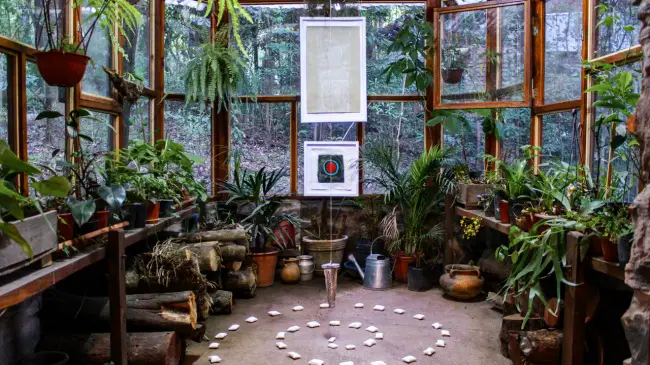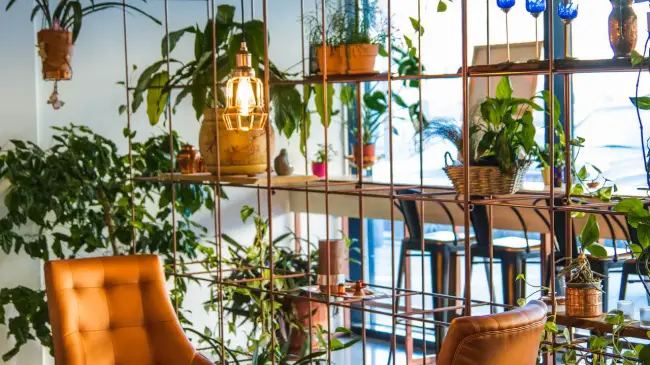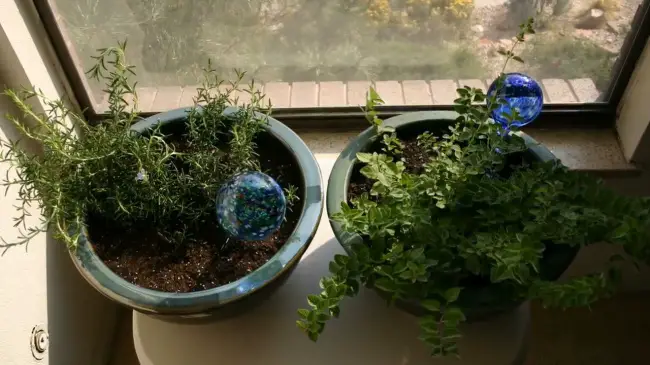Grow Herbs in Pots
All herbs require three main things to grow and thrive – enough light, sufficient water, and easy draining soil. Whether you plant your herbs indoors or outdoors does not matter. Growing herbs indoors in pots can be just as simple as growing them in your garden.
If you want herbs growing inside for easy access, it’s best to place them in a south or west-facing window, where they will receive the best sunlight.
Remember that each herb has its own growing requirements, but most do like a sunny location. If you don’t have access to the south or west-facing windows or a sunny balcony or deck, then you can supplement your light with artificial lighting. High-intensity grows lamps or fluorescent lamps will do the trick.
When you’re growing herbs indoors, put about an inch of gravel at the bottom of your pot or container before you add your soil mixture. This will allow the soil to drain properly, so your herb’s roots will stay healthy.
Use a mixture of sterilized potting soil with coarse sand or perlite added so that the soil will stay loose. Check the soil pH, and adjust it with lime if it is too acidic.
Water and Humidity
Your herbs growing indoors will need water and humidity as well. Our homes are often too dry for plants to thrive, so placing your plant pots on a bed of gravel in a tray. Adding water to the tray will increase the humidity around them. Misting weekly also helps. Any container-grown plant needs more attention than ones grown in the garden, so check them frequently. Water the pot herbs only when the top inch of soil has dried out.
Because you have the freedom to move your plants easily when they are container-grown, you can move your herbs in pots outside for the summer. Annual herbs can remain indoors, but any potted perennial herbs will thrive with a summer outdoors. Do remember to bring them indoors before frost sets in and inspect them for any insects or diseases.
By growing herbs indoors, you’ll have access to them for cooking no matter the time of year, and you won’t have to trek out to the garden for them. Just remember to use them by lightly harvesting the tips to encourage new growth, and you’ll have a healthy, vigorous indoor herb garden.
Start Growing Herbs for Your Kitchen
We all use herbs in the kitchen in our cooking and baking. Almost every recipe calls for a pinch of this or a sprig of that herb. If you love cooking as much as I do, you will definitely agree that fresh herbs, just picked from the garden, have much better flavor than commercially dried and bottled ones.
Herbs are easy to grow, can thrive in most soils (except soggy ones), and will not take up much space. Why not plant a collection of herbs, just for kitchen use, either in their own special garden or in containers just outside the kitchen door.
You will use them more often if they are close by. Choose a spot with about six hours of sun and near a source of water. Plant the herbs you use most often in your cooking, and soon you will be picking fresh herbs all summer.
You can start with purchased plants if you are a beginner, although many herbs are easy to start from seed. Farmers’ markets and roadside stands, as well as nurseries, are all good sources. Buy enough to get you started, and include your favorites for different combinations of herbs for your kitchen creations.
Include annuals like dill, coriander, basil, and perennials such as thyme, oregano, sage, and chives. Parsley, a biennial, is a must-have herb as well.
These can be potted up in containers or put directly into the garden space close to the kitchen. There are certain advantages to growing herbs in containers. If you don’t have the garden space, you can keep your herbs on a patio, plant them in a window box, or keep them on a sunny windowsill in your kitchen.
They will be easy to move around for the best light, it will be easy to water and feed them, and they will be right at hand for use. Perennial kitchen herbs will, however, grow better planted directly into a garden. Know the growing conditions best for each herb and its mature height and spread before you plant.
You can also integrate cooking herbs into your flower or vegetable beds if you can not find space for a herb garden near your kitchen door. Many culinary herbs, such as variegated sage, thyme, and parsley, make attractive additions to your landscaping.
However, if you are going to use them in cooking, never use pesticides or chemical fertilizers on or near them. For this reason alone, culinary herbs are best located in their own area.
Most herbs have the best flavor just before they flower, so keep using and pinching off the growing tips of your kitchen herbs. This will delay flowering and also encourage the plants to branch out and grow more fully.
If the plants decide to flower, then just cut the whole plant back by about a third, which will encourage new foliage growth. And, start using them more!
For best flavor, harvest your kitchen herbs just before flower buds open, when the concentration of essential oils is highest. This is especially important if you are harvesting to dry them for the winter.
Whether you will dry them, or use them fresh, pick them in the early morning, after the dew has dried, but before the sun warms them and disperses the essential oils.
Starting Your Herbs With Herb Garden Kits
Perhaps you’re a novice at this herb-growing stuff. If so, an indoor herb garden kit can be just the ticket for you to start. All herb kits come with everything you’ll need to get started, and there are many types of kits available for you to choose from.
You can choose from kits geared to culinary herbs, tea garden herbs, international herbs, healing herbs, and so on. All of them contain similar items to get you up and to run.
Most indoor herb garden kits will have the seeds and a planter to grow your seeds in. The kit may also contain a plastic dome cover so you can have consistent humidity for your new seedlings.
Some kits will come supplied with the actual soil, while others will provide you with expanding peat pellets (add water!) to start your seeds. All kits will provide you with an instruction guide with easy-to-follow directions. You may even get some recipes for using those herbs.
Since most indoor herb kits are compact and quite small, they are a boon for apartment dwellers. You’ll also have the benefit of a consistent growing environment – humidity and temperature will be constant.
You can easily regulate the amount of light your herbs get, as the small size allows you to move it about. Just think – no worries about weather conditions like frost, excess rain and wind, or drought!
Because your herbs will be right at your fingertips, you’ll probably find you use them more. It will be easy to pinch off a sprig and add some zing to your soup or chop up a few leaves and make delicious herbal butter. And you’ll be able to easily collect your mature herbs for freezing or drying for future use.
You’ll probably have so much fun with your herb kit that you’ll want to become a herb expert and start your own herb garden. This way of starting allows you to try out different herbs to find out which you’d like to grow in more quantity.
It also will give you that little confidence boost, knowing you’ve had success already. So, why not check out the available herb kits and get started!
Read also:



